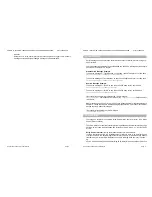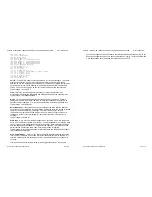
12-90
PAGING TRANSCEIVER &
STORE & FORWARD REPEATER
PRODUCT INFORMATION
SEA AIR AND LAND COMMUNICATIONS LTD, CHRISTCHURCH, NEW ZEALAND
SALCOM 12-90 PAGING TRANSCEIVER AND STORE FORWARD REPEATER
Issue 1290UB 0211
Sea Air and Land Communications Ltd
Page 2
12-90 Paging Transceiver
& Store Forw ard Repeater
GENERAL
The 12-90 is a simple to configure POCSAG paging transceiver with high sensitivity
receiver combined with a 100mW transmitter. It operates over the frequency range of
440-479MHz decoding and encoding 512 or 1200 baud, alphanumeric or numeric
messages.
The 12-90 can be used as:
•
A full paging transceiver, allowing both the encoding and decoding of paging
messages.
•
A stand alone receiver.
•
A stand alone transmitter with channel busy check function before transmissions.
•
An autonomous paging store and forward repeater with duplicate message reject.
•
A point to point raw serial link.
•
A simple telemetry solution.
The 12-90 can be controlled via an RS232 serial interface to provide numeric,
alphanumeric and tone-only POCSAG encoding. This enables a user to call a pager (over
2,000,000 codes), append an appropriate priority level (1 of 4), and add a numeric or
alphanumeric message.
The 12-90 supports multiple message queuing and will queue up to four 73 character
messages, or as many smaller messages that will fit into the available memory buffer. It
also supports full batching of serially queued and input messages, ensuring that messages
are transmitted quickly with minimal transmit on time. Pre-defined input messages can be
configured using any serial terminal application and are limited to a maximum length of 40
characters.
The unit supports 2 discrete inputs with different pre-programmed messages on high and/or
low transition. Provision to transmit a message more than once and variable time between
transmissions are catered for.
The 12-90 supports Salcom relay control protocol to control one on board relay plus several
“virtual outputs”. Virtual outputs can be used to remotely trigger input or periodic messages
and provide a mechanism to acknowledge reception of messages. The 12-90, through the
use of a virtual output, can transmit the received signal strength of the last received
message allowing the receiver positioning and system health to be monitored. The 12-90
can be configured to automatically respond with checksum information of the last received
message allowing robust, error free systems to be developed.
Expansion of the 12-90 is possible through the use of the 12-34 relay module and 12-32
input module, allowing any number or outputs or inputs to be supported.





























